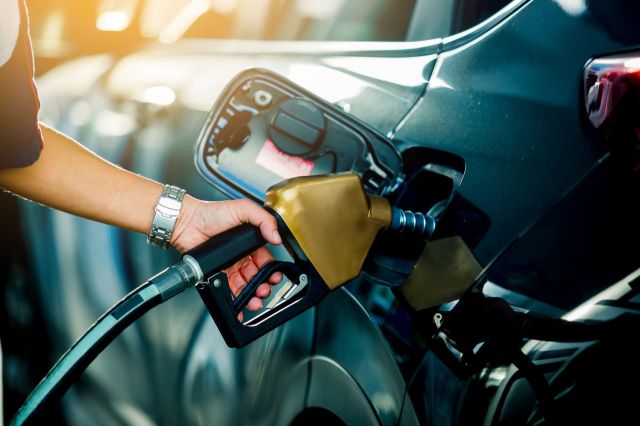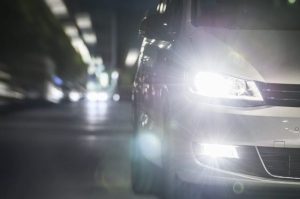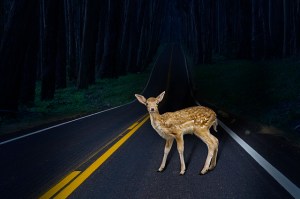We’ve all been there. You’re cruising along, when suddenly, you get a warning that you’re low on gas. You were counting on getting home without a pit stop, but now you’re wondering if you’ll make it.
Exactly how far can you drive with the gas light on? For almost every car built in the past 25 years, E is a sign you’re down to your car’s fuel reserves, according to NAPA Auto Parts, and you can drive usually another 30 to 50 miles.
So, there is no reason to panic, but try not to push it.
How Much Gas Is Left?
How much fuel remains in your tank when the fuel light is on depends on several factors, including the make and model of the car, the type of road you are on, whether it’s flat or mountainous, the temperature and how much additional weight you are carrying.
“In the cars I have test driven, most can travel anywhere from 30 to 50 miles after the light turns on,” said AAA’s Car Doctor John Paul. “In most cars, depending on engine size and miles per gallon, when the light comes on, there is typically a useable 1 to 2 gallons of fuel left in the tank. Fuel tanks never completely run dry, but the little fuel left in the tank is not enough for the fuel system to use.”
Dashboard fuel gauges rely on a floating sensor that’s attached to an arm inside the gas tank. A fuel pump, also known as the sending unit, is involved as well. As gas burns, the floating sensor’s arm begins to drop, signaling the dashboard gauge that the fuel volume is decreasing.
While 30 to 50 additional miles is a good estimate, it’s always better to err on the low end, according to NAPA, and get gas as soon as possible. The gas light should serve as a warning, not be a casual reminder to buy gas.
“It’s always a good idea to fill up as soon as possible to avoid running out completely, which could potentially damage the fuel pump,” Paul said. “Electric fuel pumps, in many cases, are mounted in the fuel tank and are cooled by the fuel in the tank. Consistently running low on fuel can lead to the pump overheating and cause a premature failure of what can be an expensive part.”
Repeatedly using the last bit of gas in the tank can also cause gunk from the bottom of the tank to pass into the engine, with the potential for causing damage.
Getting Better Numbers
Owners of cars with a multifunction dashboard may have access to more detailed information through the calculated range or distance-to-empty which can more accurately show fuel levels.
To find out precisely how much fuel you have when gas is low, read the owner’s manual to find the exact volume of the gas tank. The next time your needle is on E, fill up the tank. Then subtract the number of gallons needed to reach full from the fuel tank’s total capacity.
Once you have an idea of how much gas you have left, try to drive at a consistent speed to preserve fuel.
To prevent “unscheduled” stops and keep your vehicle operating smoothly, NAPA recommends filling the tank regularly and not letting the gas level drop below one-eighth of a tank.
If you do run out of gas on the road, members can request AAA fuel delivery. A AAA technician will bring you enough to get you the nearest gas station. To request roadside assistance 24/7, including AAA fuel delivery, go to AAA.com/GetMoving, call 800-222-4357 or download the AAA Auto Club App.
Need something for your car? AAA members get discounts at NAPA Auto Parts, online and in select stores.
Are you guilty of driving a little longer than you should after the fuel light goes on? Tell us in the comments.
13 Thoughts on “How Many Miles Can You Drive On Empty?”
Leave A Comment
Comments are subject to moderation and may or may not be published at the editor’s discretion. Only comments that are relevant to the article and add value to the Your AAA community will be considered. Comments may be edited for clarity and length.














I drive a VW 2011 GTI and I have consistently driven to work 30 miles each way and I FILL UP once a week, and always drive to the tank is on E and the light comes on. Car has 230,000 miles on it, and never had a problem concerning fuel pump or anything in the fuel system.
I’ve owned the car since 27,000 miles. DO THE MATH. LOLOLOLOLOL
RUN IT DOWN!!!!!
I drove a 2001 VW Jetta until 2012 (287K) and now drive a 2013 Jetta (226K), and I have never driven either of them into the reserve tank. I use a technique taught to me by my great uncle, whose first car was a Stutz Bearcat; he filled up every morning! and so do I. There is a BP station three blocks from my house, and I stop there every morning and top off. I can’t remember ever being below a 1/4 tank, except on the longest trips. And it doesn’t cost any more money, either.
As a senior citizen, I have practiced erring on the side of caution. And so I fill my tank when the meter shows I have a quarter tank of gas left. This way I dispense with the anxiety and fill up shortly thereafter.
Thanks for the information you have given.
I try to not let it get below half. There’s less wear and tear on the pump and less likely to pump any sediment. Also once it reaches the first red line it limits the cylinders for economy travel.
There is another problem in cold (near 32 degrees) weather. Water vapor in a more than half empty gas tank will condense into water droplets and fall into the gas. Then it can freeze in the fuel line and stop the car in its tracks. So, in winter, drive on the top half of the tank and carry “dry gas” to add to the tank as necessary.
Most cars built after 2010 (many before that) tell you exactly how many miles you have left until you are completely empty. I’ve gone down to 17 miles. Gotta do what you gotta do until payday sometimes.
Driving close to empty is asking for a failed fu pump. In modern cars, the fuel pump is probably located inside of the fuel tank, and is cooled by the fuel itself. Driving with a tank close to empty could overheat the pump to the point of failure and you will soon have a very costly repair. To avoid this, simply make it a personal goal to fill up when it gets to a quarter of a tank.
According to user manual my tank holds 16 gallons. Repeatedly when my gas gauge says empty and I go to refill, my car only takes 10 gallons, difference of 6 gallons. I haven’t figured this out. I’ve had 3 Honda CRVs. I’ve never run out of gas!
I tend to be obsessive about refilling the gas tank long before it hits ‘E’, but one time last Summer (2024), I ran into a weird situation when our Toyota Sienna (2020) gave us repeated alerts that the tank was so empty that we could only drive 5 miles. But when I refilled the tank (in a panic), it only took in 16 gallons (it’s a 20-gallon tank), so I was relieved but also more than a bit annoyed. I eventually checked with our Toyota Service Advisor, who told us the alert system is sometimes too pessimistic.
Your article seems to confuse two situations: When the “empty light” goes on, as opposed to when the gauge reaches “E”. Very different things!
On my Subaru, the light goes on EXACTLY when the gauge is at 1/8th of a tank. For my Forester, with a 16-gallon capacity, that means I probably have about 2 or 3 gallons to go until the gauge hits E. Maybe 40 to 60 miles. I haven’t hit that too many times during 15 years, but every now and then it happens.
I was hoping the article would address the REALLY important question: How much do I likely have when the GAUGE actually DOES hit E? That has happened twice, both times when I was in rural areas, usually late on a Sunday or holiday, near my destination, and was desperate for a gas station. Each time I found gas about 10 miles after the E, and each time the fill was between 15 and 16 gallons.
I’d love for your writer to address THAT concern. Carmakers must have a general design philosophy regarding how much reserve is puddled in the tank when the E itself is reached.
Thanks!
This was VERY helpful. Thanks for doing the research and sharing it with the AAA members.
Reminds me of a Seinfeld episode in which Kramer and someone else were seeing how far they could drive with the gas gauge on empty.
I think that was the episode where Kramer was test driving a new car with the salesman. Larry David humor at its finest.